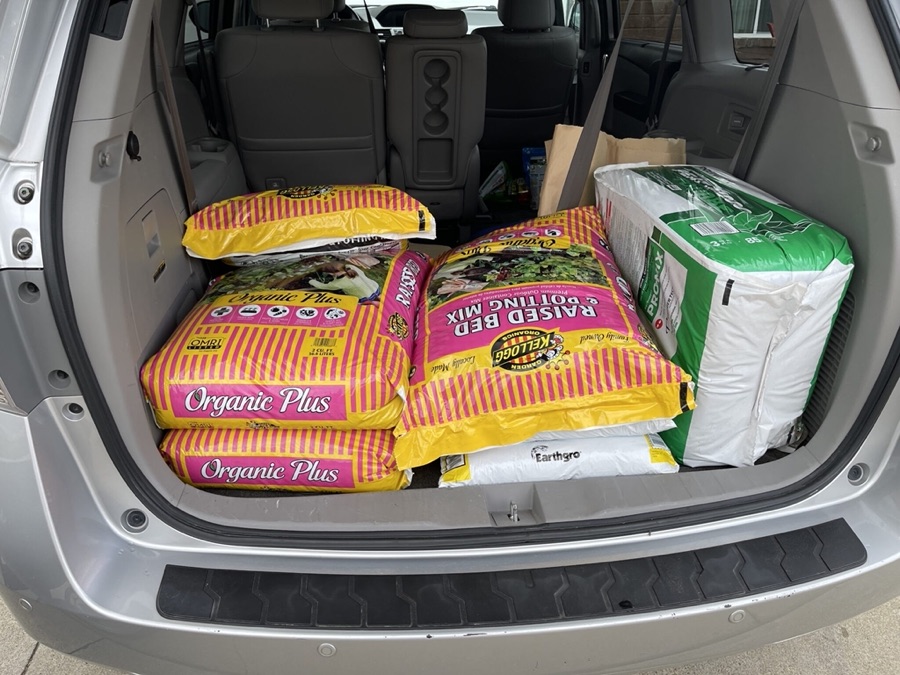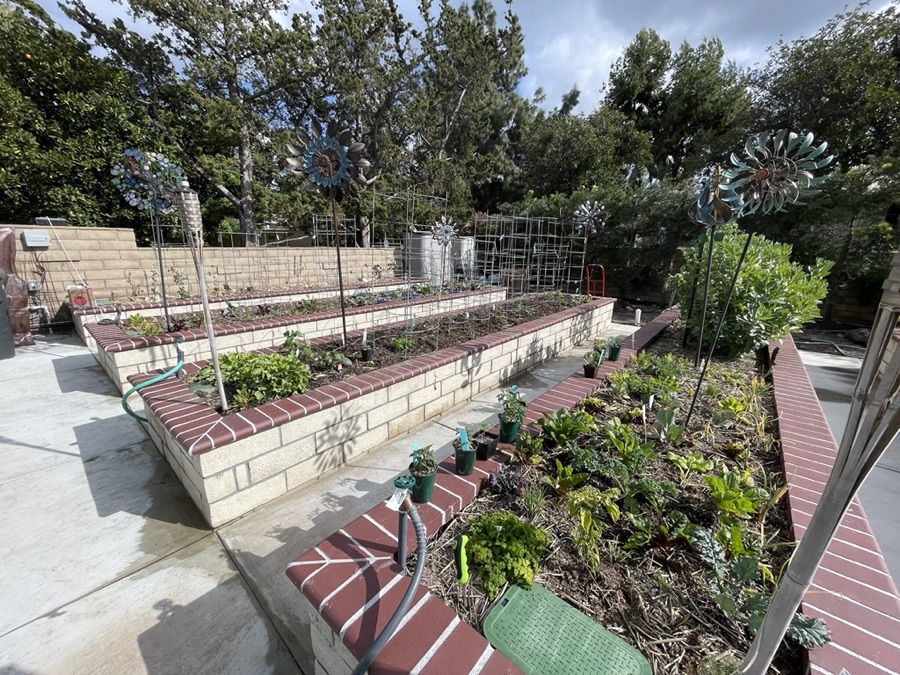Page Three: March 2023 And The Garden Gets Underway Seriously!

We will be planting and learning about all of these little guys:
TOMATOES It's hard to beat the taste of fresh homegrown tomatoes. These favorite vegetables require several months of warm summer weather to produce a bountiful harvest. Tomatoes are heavy feeders, needing rich soil and fertilizer to thrive. Choose a site that receives full sun and provide regular water and supplemental fertilizer for the highest yields. Wait to transplant outdoors until nighttime temperatures are at least 55 degrees F. Plants will need trellising, caging, or staking to support fruits.
PEPPERS This versatile warm weather vegetable comes in hundreds of different varieties, from mild to screeching hot, to suit every taste. Because of the long growing time, plants will need to be started indoors or purchased as nursery starts. Wait to plant outdoors until nighttime temperatures are consistently 60 degrees F or above. Peppers thrive in a sunny site with rich well-draining soil. Add an all-purpose fertilizer formulated for vegetables to the soil at the time of planting and keep plants evenly moist. Plants will need staking or caging to keep from bending over or breaking from the weight of the fruit.
BERRIES Though they are not vegetables, berries are a must-have addition to any edible landscape. Choose varieties that produce fruit at different times during the summer for a longer harvest. For those with limited space, select dwarf varieties that can be grown in containers. Blueberries need at least two plants for cross pollination, while other types are self-pollinating. Make sure to research cultural needs for each type. Plant in full sun, keep plants well watered during summer and cover with bird netting when berries start to ripen.
CUCUMBER These heat lovers are a favorite crunchy addition to salads, as well as for snacking or pickling. For best results, wait to direct sow seeds until the soil warms up to 60-70 degrees F. Train these vining plants on a fence or trellis, or allow them plenty of room to sprawl. Make sure plants receive plenty of regular water to keep fruit from becoming bitter or misshapen. Harvest frequently to encourage new fruit.
MELONS Biting into a sweet, juicy melon slice is one of summertime's greatest pleasures. Melons need lots of heat, water, rich soil, and fertilizer to develop ripe, succulent fruit. Choose a south-facing site that receives reflected heat and allow plenty of room for vines to sprawl. Wait to sow seeds until soil temperature is 65-70 degrees F, or plant from nursery starts. Use heat-enhancing methods such as a cloche or black plastic to warm the soil and speed plant growth.
SUMMER SQUASH Unlike winter squash, these heat-loving vegetables do not store well and are best eaten fresh. Types include green and yellow zucchini, crookneck, straightneck, pattypan, and zephyr. Choose a sunny site with rich, well-draining soil. Plant in rows or hills and direct sow seeds when soil temperature reaches 70 degrees F. Plants need 1 to 2 inches of water per week. Use drip irrigation to reduce the risk of foliar disease. Male flowers are followed by female flowers that bear fruit.
BEANS A powerhouse of nutrition, beans are one of the best sources of vegetative protein. Beyond the ever-popular green beans, there are other types to grow, including black, pinto, lima, and fava beans. Direct sow seed outdoors when soil temperature reaches 60 degrees F and air temperature is 65 to 85 degrees F. Pole beans can be harvested from mid-summer into fall, while bush types can be sown every couple of weeks throughout summer for a continuous crop. Utilize space-saving trellises and containers to maximize production.
CORN Fresh sweet corn is the quintessential summer crop, a favorite treat at barbecues and picnics. This fast-growing vegetable needs plenty of fertilizer and water to produce tender, plump kernels. Plant in 4 x 4 foot squares or multiple rows to ensure successful cross-pollination. Harvest just before eating, freezing, or preserving for the best flavor. For a unique twist, grill fresh ears and try different toppings such as aioli, pesto, mayonnaise, or fresh herbs.
EGGPLANT This delicious vegetable is prolific and easy to grow when planted during the heat of summer. In cooler climates, use heat-enhancing methods such as a cloche or black plastic mulch to warm the soil and speed growth. Provide plenty of sun, rich soil, and regular water. Harvest fruits when they are young for the best flavor. For a quick and easy side dish, brush eggplant slices with olive oil and grill on the barbecue. Season with salt and pepper and garnish with fresh herbs, cheese, pesto, or other condiments.
GREENS Though salad greens are normally a cool weather crop, there are still ways to enjoy fresh greens throughout the summer. Choose varieties such as Malabar spinach and New Zealand spinach that thrive in heat. Mustard, collards, and Swiss chard are both heat and cold tolerant. Even regular lettuce can be grown during the heat of summer when given shade and plenty of water. Re-sow every couple of weeks and harvest when leaves are young. Germination rate decreases when soil temperature exceeds 80-85 degrees F. Heat-resistant lettuce varieties include 'Jericho', 'Red Sails', and 'Buttercrunch'.
PEAS Though peas are normally a cool weather crop, they can be replanted in mid to late summer for a fall crop. To calculate the best time to plant, determine your average first frost date, subtract the days to maturity listed on the seed packet, and allow an extra week for germination. Seeds can be soaked in water overnight to speed germination. Shade new seedlings from sun during the hottest part of the day and mulch with organic matter to help reduce soil temperature. Keep plants well watered to develop flowers and pods.
TOMATILLOS Small rounded green fruits of this tomato relative grow inside papery husks. The tart fruits are a staple ingredient in Mexican cuisine, used to make green salsa or enchilada verde sauce. Tomatillos are especially cold-sensitive, preferring soil temperatures of 70-80 degrees F. Start seed indoors 4 weeks before your last frost date or purchase nursery-grown plants. Most varieties take 75-100 days to mature. Make sure to grow two or more plants for successful cross-pollination.
The Last Of The Winter Garden Was Transplanted To Make Room For Summer

The warm morning are out favorite
We are going to grow lots of tomatoes this year, and we started out by going to Roger's Gardens Tomatomania on March 3rd with Robin. See our current collection of twenty-six tomatoes with descriptions of each.

We are ready to make our selections and Robin is here to assist! Yeah!!
Few of us can conceive of cooking (or eating) without the presence of tomatoes in our diet. In the US, the tomato is the summer vegetable (or fruit?) most often grown at home--and there are plenty of cultivars to grow. The U.S. Department of Agriculture claims there are 25,000 tomato varieties.
But this delicious food didn't always have it so easy. Up until the 1800's, most people viewed the tomato with caution--and many with outright fear. Originally grown by the Aztecs and Incas as early as 700 A.D., it is thought that the first seeds made their way across the Atlantic sometime in the 1500's.
Early Europeans categorized it with a group of well-known poisonous plants of the era: henbane, mandrake and nightshade. Because of its association with nightshade (whose hallucinogenic effects include visions and the sense of flying), it quickly became associated with witchcraft. In German folklore, witches would use plants such as mandrake and nightshade to summon werewolves (in fact, the common German name for "tomato" translates to "wolf peach"); because of this, the tomato was widely avoided (by everyone other than practitioners of the "dark arts," that is).
Legend has it that one of the content turning points in the popularity of the tomato in the US is largely due to one Colonel Robert Gibbon Johnson. On September 26, 1830, standing on the courthouse steps in Salem, Massachusetts before a crowd of interested onlookers, he proclaimed his intention to eat a whole basket of the red fruit and survive. One member of the audience was his doctor, who loudly stated, "The foolish colonel will froth and foam at the mouth and double over with appendicitis. All that oxalic acid - one dose and he is dead! He might even be exposing himself to brain fever! Should he, by some unlikely chance, survive, his skin will stick to his stomach and cause cancer!" Colonel Johnson proceeded to eat the basket of tomatoes and survive with no ill effects.
Even with all its detractors, the tomato had a few fans. Some people once believed that placing a ripe tomato on a mantel of a new dwelling would ward off evil spirits and guarantee future prosperity. Since ripe tomatoes tended to go bad quickly, it became popular to make stuffed fabric tomatoes to put on the mantel. Invariably, people sewing began to use them as handy pin holders. To this day, pincushions are very commonly covered with red fabric--and many still look like tomatoes.
Today, we are much more likely to put a ripe tomato on our plates than on our mantels. We can enjoy all the different shapes, colors and flavors of tomatoes available. Here's wishing you a bumper crop this summer!

The required two people to make it up the hill!

We may have to make a sign like this for our yard!

I kept telling Mary that is too many but she insisted!

We got them home and lined them up!
We Preped The Garden With The Help Of Joe, Charlie, And Alex!
We put in 800 pounds of soil amendment and another 2400 pounds (20 bags) of composted steer manure into the soil.
Did You Know? - What is the difference between compost and composted manure? Compost consists of decomposed plant material while composted manure is decomposed animal feces that have been heated sufficiently through the composting process to remove harmful pathogens. Composted manure contains lots of nitrogen and is also a good source of other nutrients like phosphorous and potassium.
Paul hand dug about 100 square feet previously and it was a lot of work. Joe rototilled the majority of the garden saving pops a load of sore muscles. The mighty electric rototiller did a good job handled by an expert!

The van (The Grey Ghost) made several trips to Home Depot.

Alex holds the drip system out of the way

Charlie plans some of the tomatoes!

The summer garden has arrived! Now we wait!

A forest of tomato cages, twenty-six to be exact!

The relocated plants are doing well! They will be gone in a month and replaced by additional summer plants like squash, beets, string beans, eggplant, and cucumbers, etc.

The iron forrest!


